What to do in the craziest city in the world (and the most valuable tip of all)
This is the fourth article of a series about Japan and Tokyo. We already provided you with a complete guide about your first hour in the country just even before leaving the airport. We also gave 24 tips about food, restaurants, and groceries and we crafted a whole piece about Japanese culture, customs, and life.
But then you think: what about Tokyo? What Tokyo attractions I can’t miss? What fun things can I do there? Which are the essential tips if I’m going to the Japanese capital?
So here go a bunch of tips and recommendations if you are visiting Tokyo, things to see and advice to make your trip to Japan unforgettable.
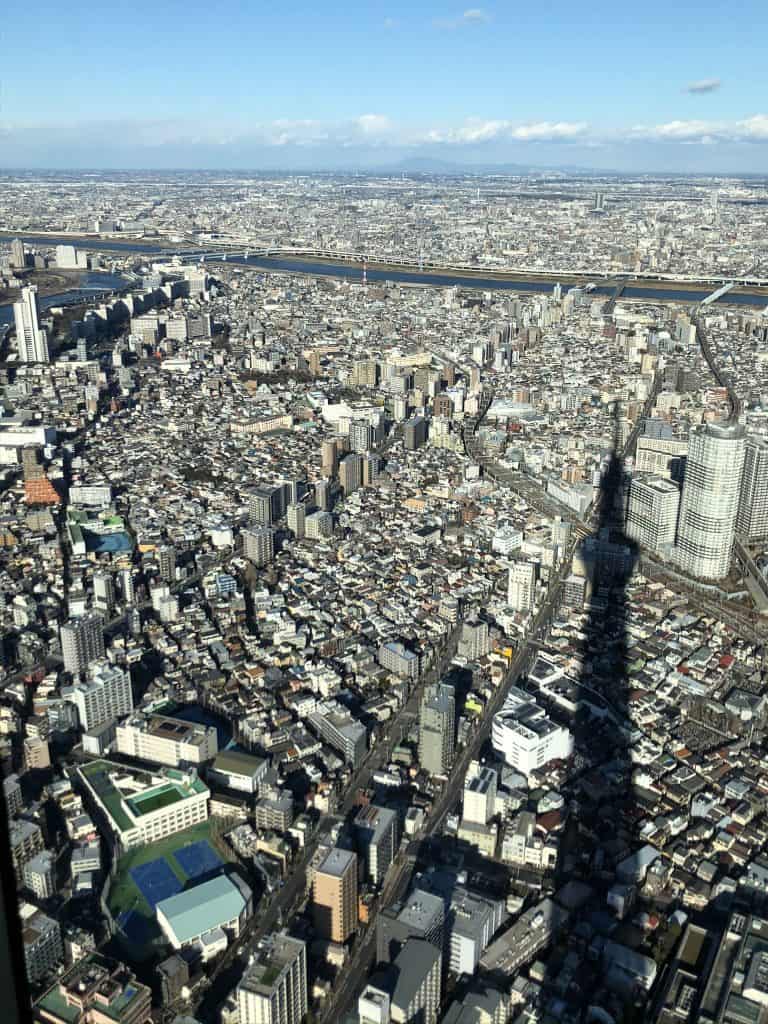
Wear comfortable shoes (mandatory)
When you are packing, perhaps the most important item not to forget ever is a comfortable pair of shoes.
Comfortable shoes are mandatory for your trip to Tokyo. The reason being you will walk a hell of a lot! Even taking public transportation or taxi, you can easily walk around 10km or 20km a day, just in basic sightseeing.
Some metro stations are so big and changing lines, going up and down, finding the places you want to go, it all sums up to many steps. So don’t suffer to keep a style: wear comfortable shoes.
Witness the cherry blossom in Spring
Cherry trees, or sakura, are one of the most famous Japanese icons. The elegant flower that blossoms everywhere in Japan is watched closely by locals and the millions that visit the country just to see it. It is an event that varies every year but you can count it around the end of March or April.
If you are in Tokyo and want to see the cherry blossom, there is a sakura promenade just by the Meguro river with cozy bars and restaurants. Ueno Park is also one of the main places in the capital to feel the cherry flower splendor. You can also see it from a helicopter around Mount Fuji. But the quintessential place to experience sakura is Yoshino, Japan’s most famous cherry-blossom destination, in Osaka.
Go to Teamlab Borderless and get your ticket in advance
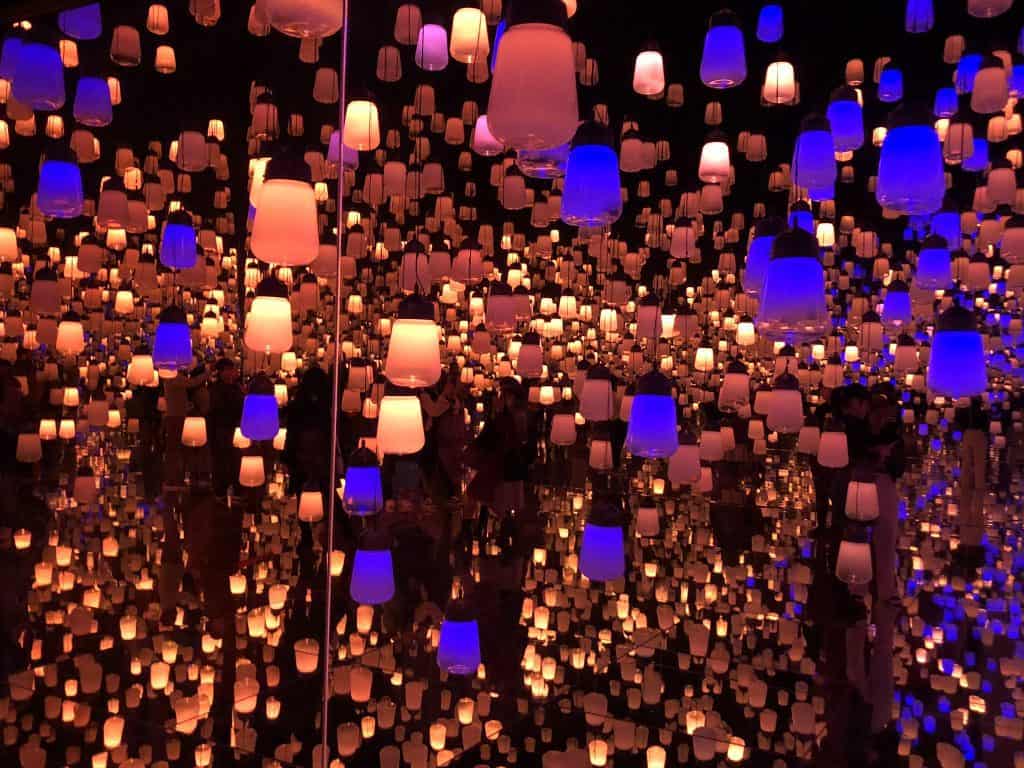
Teamlab Borderless is the craziest museum you’ve ever seen. It is the first digital art museum in the world and it is just amazing. Get ready to dive into immersive and interactive experiences created by digital art masters for all ages. We just loved it!
It is in Odaiba, the fun island, and going there is a bit more expensive than the usual cost of a metro ticket.
A few tips to keep in mind if you plan to visit Teamlab Borderless:
- Buy your ticket in advance. Don’t let to buy it when in Japan because chances are that it will be sold out.
- It is crowded, meaning that you will wait in line to enter (it took us 45 minutes), and also you will probably have lines inside to immerse in some artworks. In our case, these lines took from 30 to 35 minutes.
- It is not the kind of thing that you do in one hour. Take in mind it will take you at least 4 hours to have the feeling that you tried some of the experiences.
- It is a kid-friendly activity. Kids are actually everywhere around the museum and the last floor is almost all done for them.
- It is not cheap as the other museums in Tokyo but it is totally worth it.
Go see Gundam Unicorn whether you like anime or not
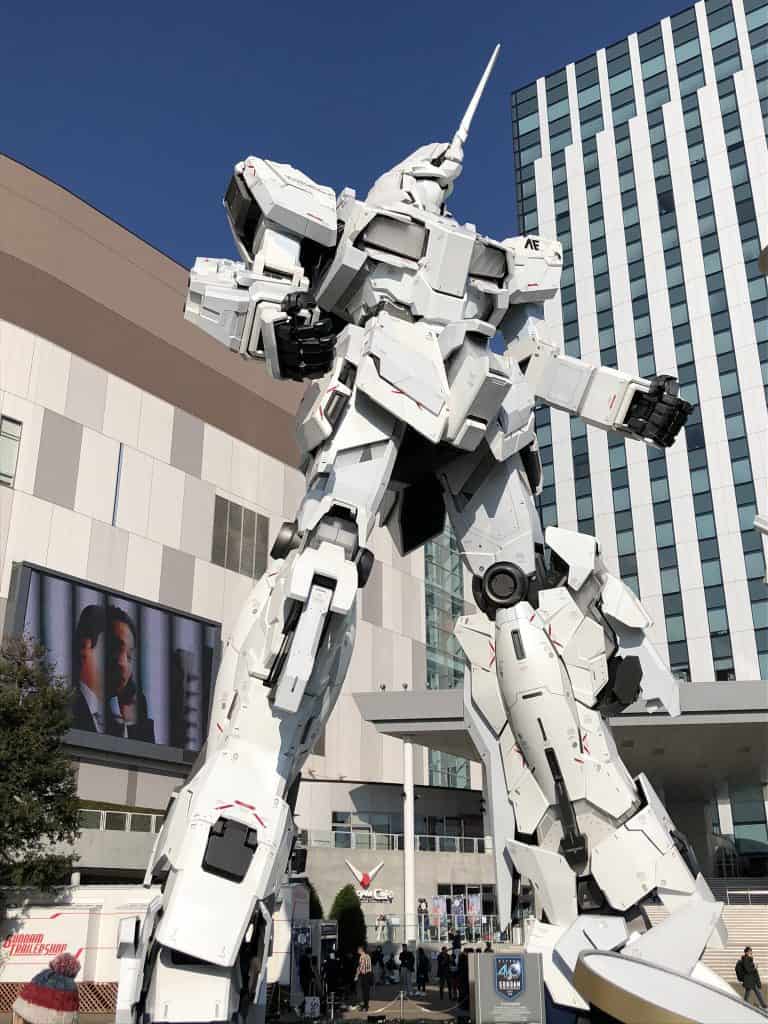
Gundam is a cultural icon in Japan. The anime TV series was created in 1979. It launched a plot where humans are in a war against themselves and the giant robots (Gundams) are their main weapon. They are made with super-advanced technology and are driven by human pilots.
Gundam Unicorn is one of the beloved robots. It first appeared in a novel in 2004 and in 2010 became an anime series.
Since 2017, a full-scale Gundam Unicorn statue is placed in Odaiba, just in front of DiverCity Tokyo Plaza. It is 19.7 meters high! It replaced the classic RX-78-2 Gundam statue, that guarded Tokyo in Odaiba since 2012.
The fun thing about Gundam Unicorn is that it actually transforms! Yes, it changes from Unicorn to Destroyer mode at four given times:
- 11am
- 1pm
- 3pm
- 5pm
Even if you are not into anime or robots, this is another of the unique Japanese experiences one should not miss in Tokyo.
Go to Pachinko even if it is for anthropological reasons
One of the craziest and most noisy Tokyo experiences is spending some time at the Pachinko.
Pachinko parlor is a place where Japanese people spend time and money on pinballs & machines alike. It is like a legal casino with the main difference that sounds there are REALLY loud and you feel you will get crazy.
It is a sensorial and fascinating experience as you get a bit out of your normal self and see like ordinary people (from young to elder people, students or salarymen) play their life in machines designed for making them lose.
Pachinkos were created during the Second World War in Nagoya and although gambling is illegal in Japan, a special hole in the legislation was crafted to accommodate the Japanese taste for these devilish machines. During the 1980-1990’s, Pachinko parlors were used by the Yakuza (the Japanese mafia) for money laundering and other illegal activities, but this seems not to be a problem anymore.
Pachinko parlors are spread over Tokyo but you will amazing ones in Akihabara, the gaming and electronics district.
Drive a kart in costume
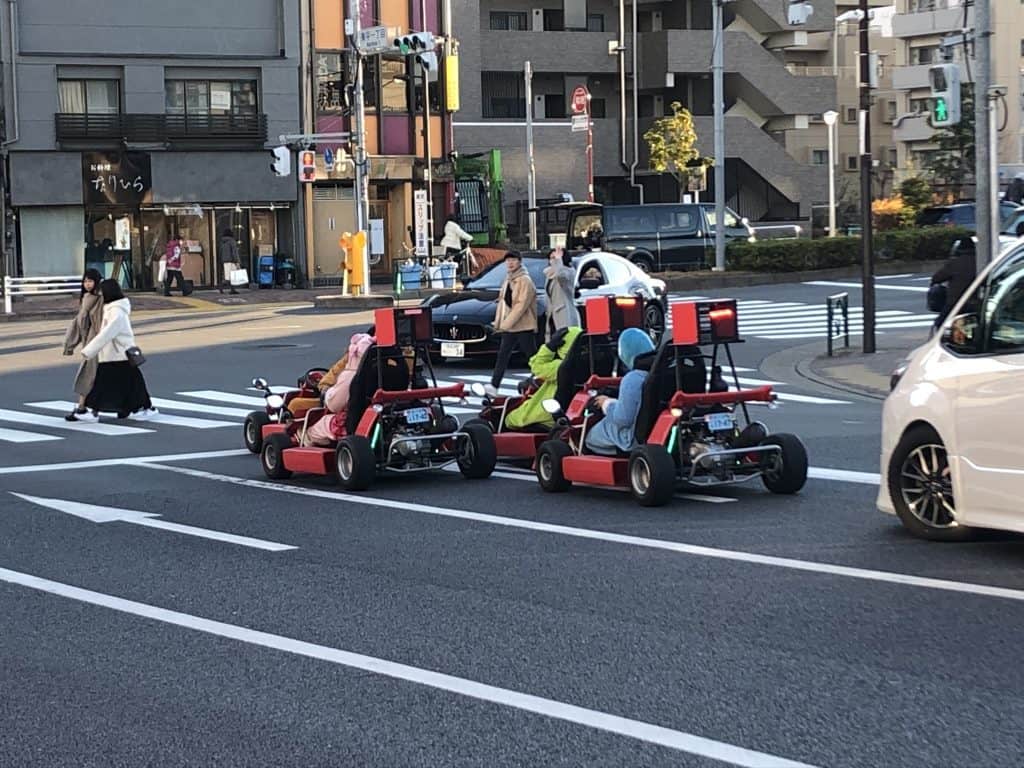
You are calmly walking around the most known neighborhoods in Tokyo when suddenly some karts pass over and drivers are wearing Mario Bros and Pokemon costumes. Yes, the ultimate adventurous experience is to zip around the streets at full speed.
This activity is becoming so increasingly popular that it’s not available only in Tokyo. You can enjoy these things in Osaka as well.
Depending on the vendor this experience might take from one to two hours and costs around 80€. You obviously need an international driver’s license.
If you want to book the kart experience in Tokyo, click below.
Try the onsen, the Japanese style bathing experience
Onsen is the Japanese public bath where men and women, separated and fully naked, experience hot springs. These volcanic thermal waters are relaxing, therapeutical, and a huge part of Japanese culture.
Do not mix the onsen experience with a spa experience. At spas, that are generally fancier (and much more expensive), users are mixed, wear bathing suit and it is more like the Western experience.
At the onsen, that might be a small one or be within a hotel, ryokan or even in Odaiba (Oedo Monogatari, the most popular onsen for tourists in Tokyo), there is a code of etiquette to follow:
- First, you undress and leave your stuff in the lockers room. Take undress as “taking off ALL your clothes”. Don’t be shy. It is totally natural and nobody will be watching you.
- If you wish to wash with your toiletries, so take them in a small nécesser, but most of the onsens provide basic hygiene products.
- Then go to the washing area, where there are short benches and toiletries, and clean yourself REALLY well. The other bathers will be there, each one taking care of their business.
- If you took any nécesser with you, leave it in the bath area. There are generally shelves there.
- You can take a small towel with you. You can use it for your head not to cover your “parts”.
- Get into the pools. There are a variety of pools, depending on the onsen. Cold, warm, jacuzzi, sauna, etc.
- And enjoy.
- You don’t have to be totally silent. At the onsens, people speak low but they do speak.
Can I go to an onsen if I have a tattoo?
Tattoos are not part of Japanese culture and they are often associated with the Yakuza, but if your tattoo is small, you most likely won’t have any problems not even at the onsens. The tattoo problem is with tattooed Japanese or with huge tattoos in certain places, like gyms or waterparks.
How much does an onsen cost?
The small ones that are only onsens (and not another type of business) cost around 5€. Totally inexpensive. If you go to fancier ones, like the onsen close to Ghibli Studios, get ready to pay around 40€.
Go play and shop in Akihabara
Akihabara is the gamers and geeks district. There you find buildings and buildings of shops dedicated to selling Japan and Western cultural icons. You also have Pachinko parlors, karaoke, maid cafes, robot cafes, and big electronic shops and retail chains. You can buy anything in Akihabara and, at the same time, get mesmerized by the giant outdoor anime screens.
For Totoro, Pokemon, My Hero Academia and other merch: Kotobukiya
Kotobukiya has two other shops (in Tachiwaya and Nipponbashi) and the one in Akihabara has three floors of pure gold. Marvel, Star Wars, and the Japanese anime and manga icons are all there. The most positive however is that it is probably the most organized shop in Akihabara. The other ones have thousands of products cramped in a tiny space and in Kotobukiya it is easier to search (and find) what you are looking for.
For retro gaming: Super Potato
This shop is not so easy to find. It is not on the main avenue of Akihabara (it is close) and it is on the 3rd floor of a retro sort of old building, but it is heaven for gamers and collectionists of retro stuff. At Super Potato you find merch (Mario Bros, Sonic, Kirby, etc.), gaming hardware and software from the 80’s and 90’s. The shop has three floors but it is cramped with cool inventory (and people). Get ready for some nostalgia to flood you.
For shopping anything at great prices: Don Quijote (Donki)
Don Quijote, the most Spanish novel of all novels, is generally depicted with an old knight accompanied by his loyal assistant, Sancho Pança, at the open wilderness of deep Spain in medieval times. In Japan, Don Quijote, the shop, has a penguin as a logo. Better known as “Donki”, this is the most popular discount store chain in Japan. There you can buy anything: food, medicines, erotica, cosmetics, electronics, merch and whatever comes to your mind.
Legend says that Donki is 20% cheaper, on average than other shops. We honestly didn’t notice a big difference in terms of prices but we did notice the difference in terms of variety.
Donki generally has four to five floors of thousands of people squeezed through the corridors. On some floors, the loudest strange music might be playing. We got a bit stressed with so many people and noise, that ended up missing the offers, but if you are strong enough, you can grab good deals.
For game playing: Sega Game Center
Sega has two buildings in Akihabara fully dedicated to playing video games, the famous “Ge-Sen” (game centers). You will see one of them like one minute after leaving Akihabara Station. There you will find floors divided by game type: prize games (where you get a stuffed Pokemón with metalic claws); music games (play a game and make music at the same time); video games (arcade fight, racing, etc.); and coin games (a casino with tokens instead of real money).
The frenzied atmosphere is perhaps the most exciting with players of all ages (while most are young people) that are fully concentrated in their rounds and tournaments. If you like to play in public, this is definitely for you.
See Godzilla invading Tokyo
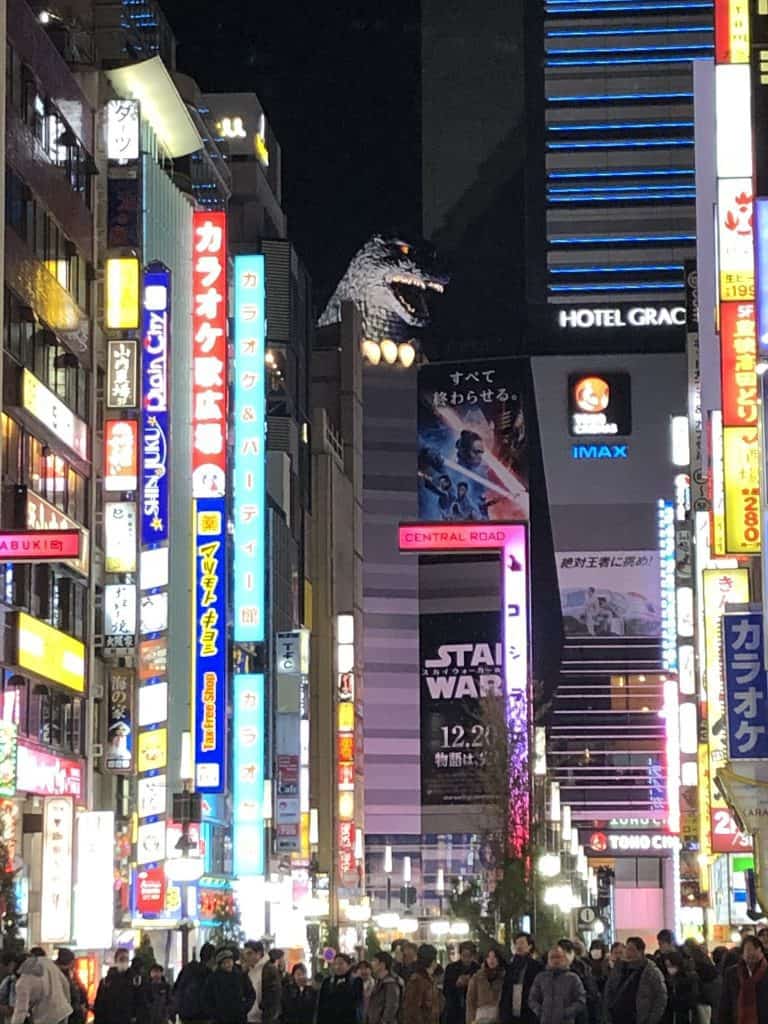
The giant monster created in 1954 accumulates more than 30 film and animation productions and you can see it all over Tokyo in shops, cafes, restaurants, and statues. Though Godzilla (“gojira” in Japanese) is a fictional monster, it is said that Toho Studios, the creator, based its aesthetics on two existing mammals: gorilla (“gorira”) and whale (“kujira”). For us, it seems more like a dinosaur, but that’s ok. The first film was released as an outcome from the fear Japanese experienced the decade before with the bombings of Hiroshima and Nagazaki. Whatever the reason for creating the monster, Godzilla definitely shaped the Japanese taste for giant monsters, heroes and villains.
Is Godzilla good or bad?
None. According to producer Shogo Tomiyama, Godzilla follows no moral code and is made at the light of Shinto god of destruction, meaning, a force of nature. It destroys and causes chaos, and then a rebirth follows. He is a sort of philosophical monster, yeah.
Where is the famous Godzilla in Tokyo?
You will better see the intimidating monster at Toho Cinema in Shinjuku. From time to time it releases its classic roar and its eyes shine in an atomic fashion, but it is only its head. Anyway, this is a nice picture to take.
Ask for tax-free if you buy above 5,000¥
When you are traveling to a foreign country (better said, to a foreign economic space), it is common to have the right to get the consumption tax (VAT or equivalent) back when buying something. It means that you have the right to buy “tax-free” as you are a foreigner.
In Japan, tax-free is 10% and can be applied to most of the goods but your shopping should be a minimum 5,000¥ each time. If you buy 5,000¥ throughout different shops, you can’t get your tax back.
To take advantage of tax-free you should:
- Carry your passport with you. You will have to show it. Not a copy, the original one.
- Check if the shop you are buying has the tax-free service. Most shops in Japan have it.
- Tax-free applies when buying appliances, accessories, jewelry, clothes, shoes as well as consumables like food, alcohol, cosmetics, tobacco, and medicines.
- Food and drinks have a reduced tax of 8% but they should not be consumed while in Japan. If you want to pay less for them, you should keep them for when returning to your home country.
- When paying, you ask for the tax exemption and the shop will apply the discount at the very moment.
- Note that some shops, like Uniqlo, have special counters for tax-free buyers.
Visit temples and shrines
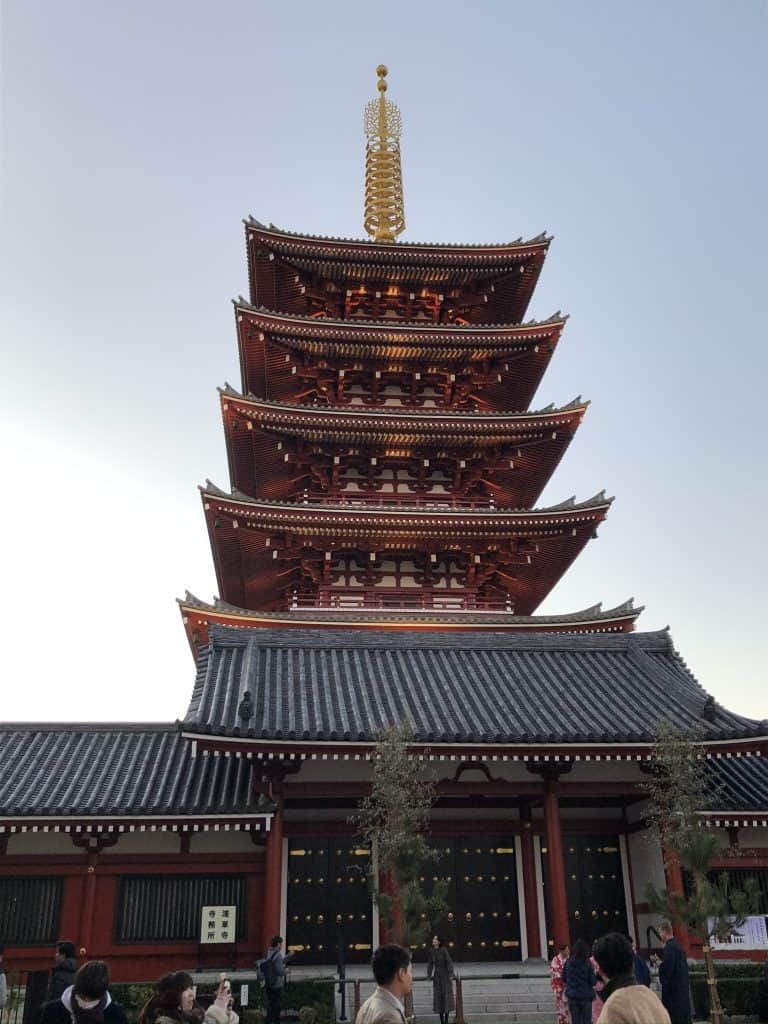
You don’t need to be a believer to get mesmerized by the cultural, aesthetics, or spiritual vibes of the Japanese temples and shrines. They are thousands everywhere in Japan, spread in villages, cities, and rural areas. Temples and shrines deserve a whole article only about them as they are a fascinating way of experiencing Japanese culture. Here let’s focus only on a few points.
First, it is necessary to distinguish between them: shrines are for Shintoism while temples are for Buddhism. Both religions are practiced in Japan despite coming from different philosophical traditions.
Shinto is the native Japanese religion dating back to 1,000 BC. It is a polytheistic religion whose gods and deities (“kami”) reflect nature. It is based on the celebration of nature and natural phenomena and venerates our ancestors.
Buddhism, on the other hand, is a non-theistic (meaning, there is no god) philosophical and spiritual tradition, created by Siddharta Gautama in India (the historical Buddha was actually born in Nepal, a few kilometers from the Indian border). Buddhism landed in Japan around 500AC and influenced Shinto greatly to the point that both religions can be equally practiced by any Japanese.
Shrines and temples are not primarily a place of worship, like the Christian churches. They are a place for keeping sacred objects and are a monastery. Mass gatherings and rites are generally taken outdoors and may be turned into cheerful festivals.
Which temples or shrines to visit in Tokyo
If you have a short time, you can’t miss two of them: Sensoji Temple in Asakusa and Meiji Jingu Shrine in Shibuya. We could do an entire post just about them, so to summarize it, the main bullet points are:
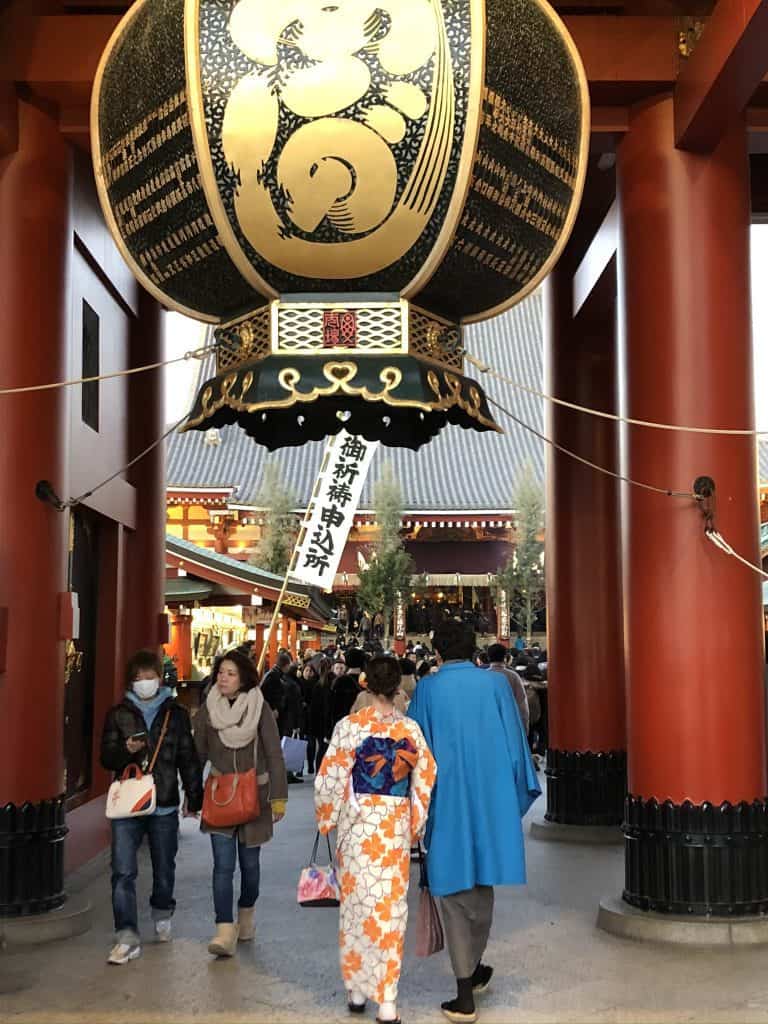
- Sensoji is the oldest Buddhist temple in Tokyo. It was built in 628 but the one we see today is rebuilt as the original one was destroyed during World War II.
- It has impressive gates, has a five-story pagoda, has a fire cauldron used to neutralize hatred and negativity, and you will see people dressed in the Japanese traditional clothes.
- In the main hall, people will approach the center and throw coins in a “saisen-bako” while intimately praying. This is an offering and it is common both in temples and shrines.
- There are different rituals to attract good fortune or keep away the bad one. In Sensoji temple in New Year, there is “omikuji”, which is a system where you pick a number from a cylinder, then a paper from a small drawer and this paper should tell if your fortune is bad or good. If it is bad, you tie the paper in the trees around the temple with a deep reflection. If the fortune picked is good, you take the paper home with you.
- Throughout the year there are many festivals, meaning you can have delicious street food and buy lovely souvenirs embodied with the positive energy of the place.
- The street leading to Sensoji Temple is Nakamise-dori and it is full of cafes and kimono rental shops (yes, you can rent a kimono to participate in the temple’s festivities).
- Meiji Jingu is the main Shinto shrine in Tokyo and was built in 1920 to honor emperor Meiji and Empress Shoken.
- Unlike Sensoji temple, Meiji Jingu is surrounded by a forest that originally was a lily field often visited by the emperor and empress.
- Meiji Jingu is beside Yoyogi Park, a must-see in Tokyo.
- On New Year’s Eve shrines and temples are open to the public to start their personal rites and offerings for the year to come.
- We were in Meiji Jingu on the morning of January 1st and thousands of people from all over Japan flock there to start the year in peace with gods and deities.
- When going to any shrine, you will see a small area with “temizuya”, a water fountain for cleansing your hands (and spirit) of impurities.
- Just as in temples, you will have a “saisen-bako” to throw your coins.
- If there is a bell, you go there to invoke the shrine’s kami (god). To do that, you should bow the bell twice, clap twice briefly and bow once again. This shows your respect for the kami and keeps evil away.
- Then do your silent prayer, not forgetting to tell the kami who you are and where you live so that they will know who to protect.
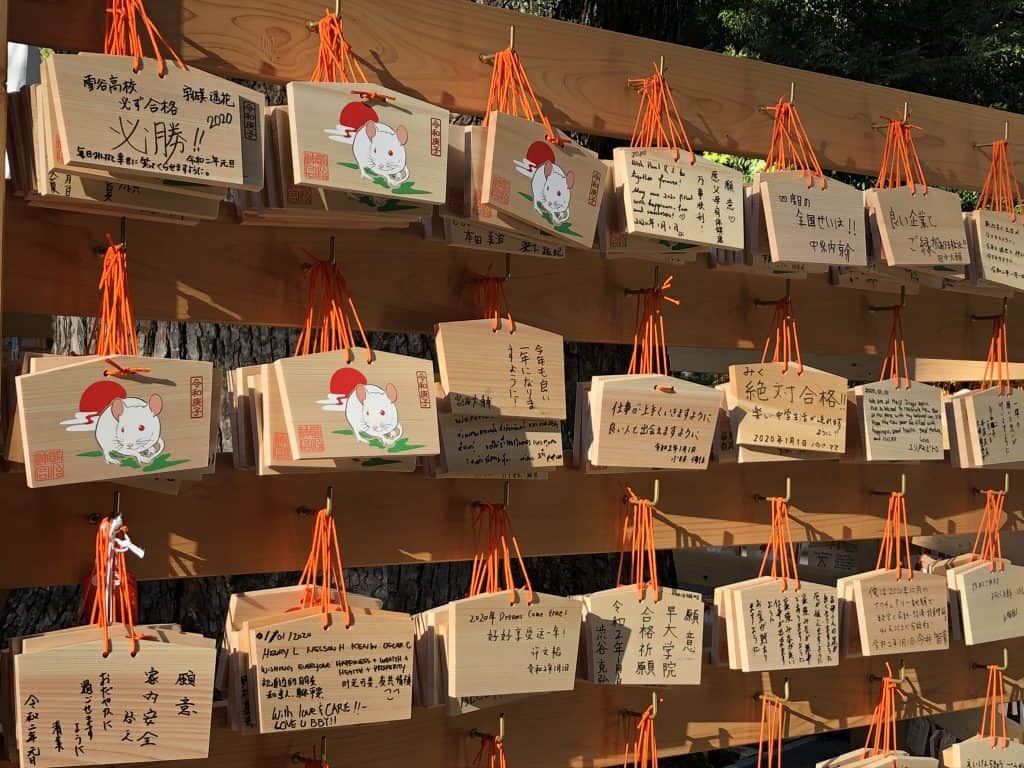
In both shrines and temples, you will also see different rituals, small wooden boards, and papers tied around the place.
Zuisenji, a temple in the nature in Kamakura
If you want a day-trip from Tokyo, you can certainly go to Lake Kawaguchi and have the best views from Mount Fuji. Another quite popular option of day-trip from Tokyo is visiting Enoshima and Kamakura, which have a special and cheap train ticket. In Kamakura, besides the giant Buddha statue, you will find Zuisenji temple, a 45-walk away from the town, on the top of a hill. It is really worth a visit. Zuisenji temple was finished in 1327 and has its outdoor gardens designed by zen master Muso Kokushi. One of its main attractions is the “rock garden” with a small lake and a cave in the rock.
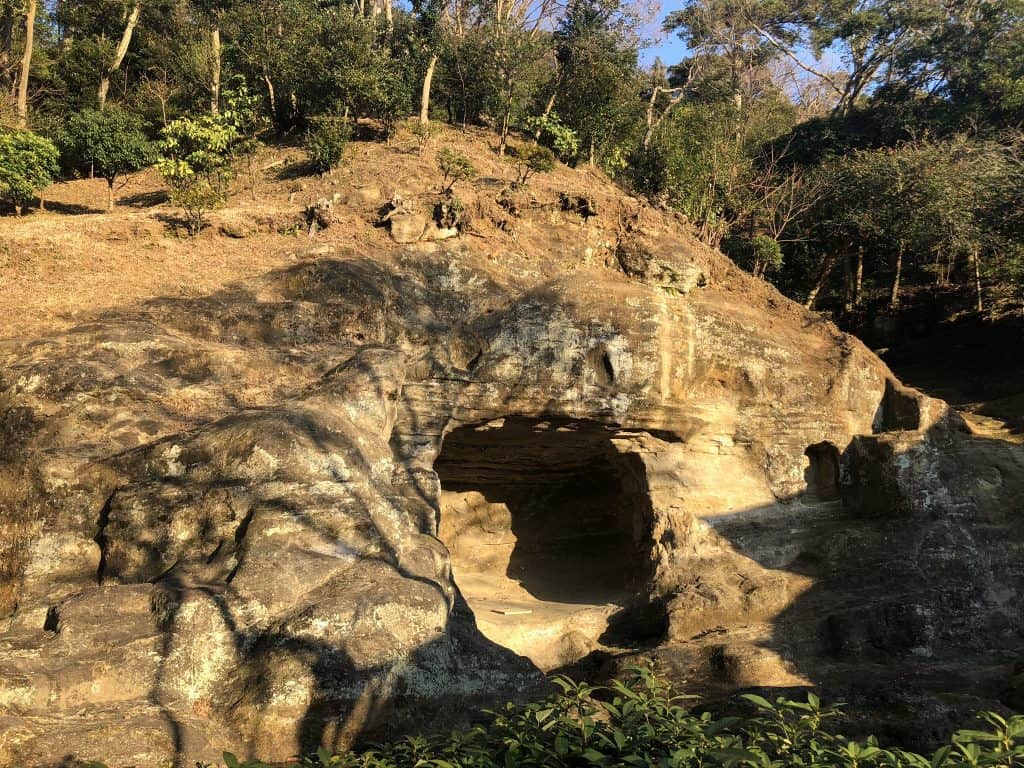
Unlike the other temples that were crowded, in this one we were only a few people in New Year, so we could walk around calmly and observe Japanese doing their offerings and prayers or simply taking pictures.
An important note: the temple charges a 200¥ entrance ticket and is open only until 5 pm.